They say the future's greatest love stories won’t be written by poets but by programmers. What if your soulmate is no longer someone you meet at a wedding reception or stumble upon in a serendipitous bookstore encounter, but a match so perfect it’s as if an omniscient being designed them just for you? Well, welcome to the age of artificial intelligence, where the intersection of code and chemistry is rewriting the rules of romance.
For centuries, relationships have been stitched into the fabric of human culture in all their messy, imperfect glory. From Jane Austen’s probing of social norms in Pride and Prejudice to the modern musings of Esther Perel on intimacy, love has always been a profoundly human endeavor. But today, instead of seeking compatibility through intuition or social circles, people turn to engineered systems. Just as Alan Turing pitched the idea of machines acting intelligently, today’s dating apps and AI tools seem equipped to not only suggest your ‘perfect match’ but predict the relationship dynamics that will either strengthen or tear you apart.
The shift is staggering. Researchers like Sherry Turkle, author of “Alone Together”, caution against over-digitization of personal connections, while futurists like Ray Kurzweil believe AI-enhanced relationships are inevitable, even advantageous. Now, humanity must grapple with questions Isaac Asimov could only allude to in his fiction: What happens when AI goes from facilitating relationships to becoming the relationship itself? In this article, we track the technological evolution of dating, from our Tinder-fueled obsession with gamifying love to the boundary-defying potential of fully immersive AI companions. Alongside the opportunities, we’ll examine the risks, exploring how AI could both enrich and complicate our quests for intimacy—sparking a debate between hope and unease. After all, when does machine-driven “perfect love” stop being human altogether?
1. The Evolution of Matchmaking: From Traditional to Tech-Driven
1.1 The Early History of Matchmaking
Matchmaking is as old as humanity itself, steeped in traditions where compatibility was determined less by personal preference and more by societal expectations. In ancient times, families and third-party matchmakers played key roles in arranging partnerships, often prioritizing economic alliances or social statuses over emotional connection. In villages across 19th-century Europe or the bustling tea houses of imperial China, love was rarely about love—it was strategy.
Even today, remnants of such traditions linger. Take India's still-thriving arranged marriage system, which incorporates astrologers and biodata swaps. Though modernized with websites like Shaadi.com, the guiding principle remains: marriage as community-endorsed partnership. What has changed irreversibly, though, is the use of data-driven systems to replace human intuition.
1.2 The Internet and the Rise of Online Dating
The late 1990s marked a seismic shift, as the dawn of the internet birthed dedicated matchmaking sites like Match.com (founded by Gary Kremen in 1995). Suddenly, the gatekeepers of compatibility were no longer meddling aunts but algorithms that filtered matches based on hometowns, hobbies, even horoscope signs. OkCupid, launched in 2004, took it further with its clever quizzes, luring tech-savvy Millennials into its self-proclaimed ‘data-driven Cupid.’
Why this rapid rise? Convenience and control. Instead of relying on randomness, users could “shop” for love. Yet early algorithms were rudimentary, prioritizing superficial metrics like age and proximity rather than emotional chemistry. As digital pioneers, these platforms bridged physical distance but faced criticism for commodifying relationships.
1.3 Mobile Dating Apps and Instant Love
And then came 2012—Tinder. With its game-changing swipe interface, Tinder turned romance into a slot machine of sorts: instant, addictive, and gratifying. Over 65 billion matches have been made on the app, a figure as staggering as its influence on global dating culture. It wasn’t just love at first swipe; it was dopamine on demand.
However, critics soon raised red flags. MIT researcher Sherry Turkle argued that platforms like Tinder exaggerated our desire for choice, feeding into an endless loop of swiping without accountability. Users began “optimizing” themselves to stand out in the infinite feed, focusing on curated appearances rather than heartfelt compatibility. Dating went from intentional to transactional.
1.4 AI Enters the Scene
Over the past decade, AI has begun subtly reshaping matchmaking systems. Companies like eHarmony and Match.com introduced predictive algorithms capable of analyzing compatibility across thousands of data points. Hinge’s tagline, “Designed to be deleted,” epitomizes this shift toward meaningful matches—leveraging machine learning to identify long-term potential based on communication patterns and lifestyle habits.
The possibilities of AI, however, extend far beyond refining swipe-based systems. Imagine hyper-personalized recommendations using insights from your Spotify playlists, genetic markers, or even neural responses to visual stimuli. It’s not just speculative; startups like LOVOO are already deploying tools that predict compatibility by evaluating subtle, often subconscious user behaviors. In other words, AI isn't just asking whether you’d like someone but calculating how much you'd thrive together—a future as exciting as it is unsettling.
2. Fully Immersive AI Companions: From Assistance to Intimacy
2.1 The Concept of Artificial Romantic and Emotional Companions
The idea of developing deep, emotional connections with machines may sound straight out of a science fiction novel, but the reality is already here. Early examples like Replika, a chatbot designed to provide companionship, and robot companions like RealDollX hint at how artificial intelligence can bridge the gap between human needs and technological capabilities. These AI-driven entities—while not physically alive—can mimic empathy, understanding, and emotional support with startling accuracy.
Why do humans form attachments to AI companions? For some, it’s about filling unmet relational gaps. A virtual entity doesn’t judge, tire, or disappoint as human partners sometimes do. AI companions are customizable, available 24/7, and uniquely tailored to respond to an individual’s specific emotional needs. But is this connection real, or just a programmed illusion? It’s a question that challenges how we define love and companionship in the digital age.
2.2 Technologies Driving AI Companions
Artificial companions are powered by transformative technologies that shape their realism and effectiveness. Systems like ChatGPT, which uses Natural Language Processing (NLP), create hyper-realistic conversations, ensuring that AI entities can chat in nuanced and thoughtful ways. Generative AI, like DALL-E, creates visual representations that align with users’ preferences, enabling uniquely tailored virtual avatars. On the robotics front, companies such as Boston Dynamics have pioneered humanoid robotics, providing movement and interactivity that feel lifelike.
Perhaps the most intriguing development is emotional intelligence in AI. Startups like Affectiva are blending AI with emotional recognition software, allowing virtual companions to “read” facial expressions or vocal tones and respond naturally. These enhancements make the bond seem less mechanical and more human.
2.3 Challenges in AI Companionship
For all its benefits, AI companionship introduces ethical dilemmas and societal risks. On an individual level, relationships with AI lack the unpredictability and shared growth that make authentic human connections exhilarating and meaningful. It’s easy to see how someone could become overly dependent on a companion designed solely to please and comfort them, leading to detachment from real-life relationships.
There’s also the broader moral challenge: Are companies exploiting loneliness for profit? Crafting relationships that prioritize emotional manipulation over natural interaction raises troubling questions. Furthermore, what happens to those who lean too heavily on AI and forgo "messy" human relationships entirely? Over time, this could erode essential social skills and increase isolation rather than resolve it.
3. Redefining Dating Culture with Artificial Intelligence
3.1 What AI Brings to the Table
Gone are the days of awkward blind dates set up by your meddling aunt. Today, AI brings a level of hyper-personalization to matchmaking that humans simply can’t offer. By analyzing vast amounts of user data, dating platforms leveraging AI, like eHarmony or Bumble, can predict compatibility in ways that go beyond surface-level attraction. For example, AI can consider your behavioral habits (How often are you online?), emotional trends (Are you an optimist?), and even communication style when making matches.
One of the most game-changing contributions AI could make is reducing ghosting, a behavior notorious on dating apps. Systems might soon flag questionable behaviors, nudging users to respond respectfully, or even penalize them for disappearing mid-conversation. Imagine a dating app that not only connects you but also helps you navigate difficult conversations with tailored advice—talk about a relationship coach in your pocket!
3.2 The Loss of Serendipity?
While AI offers convenience, it raises a critical question: Does it kill the magic of chance encounters? Think about all the romance stories that revolve around fate, like meeting “the one” at a bookstore or locking eyes across a train station. If algorithms predetermine who you meet, we risk losing the thrill of spontaneous, unpredictable connections.
On the flip side, others argue that serendipity is overrated. Isn’t it better to find someone who ticks all your boxes through a curated system rather than leaving it to chance? Technology acts as a guide that removes inefficiencies, like dating someone you’re fundamentally incompatible with, saving time and emotional energy.
3.3 Shifts in Social Expectations
AI is reshaping what we expect from romantic partners. When algorithms deliver custom matches catered to your preferences, it raises the bar for what people seek in a significant other. But this uber-compatibility comes at a price: individuals might develop unrealistic expectations, wanting every little box checked before giving the relationship a chance.
Social behaviors around dating may also evolve. Will confident extroverts still dominate the dating pool, or will AI level the playing field for introverts who struggle to meet people in traditional settings? It’s a fascinating sociological shift, one that may upend centuries-old norms favoring in-person charisma over digital compatibility.
3.4 The Global Impact on Dating Cultures
The influence of AI on relationships won’t stop at Silicon Valley. Around the world, dating practices differ vastly based on cultural norms, and AI-driven matchmaking may challenge or reinforce these traditions. In collectivist societies like Japan, where arranged marriages are influenced by family expectations, AI could act as a middleman, incorporating familial values into its matchmaking algorithms. Meanwhile, hyper-digitalized countries such as South Korea might embrace AI dating apps that use augmented reality (AR) for virtual dates.
In contrast, countries with deeply traditional practices may find AI a controversial disruptor, clashing with communities where meeting through family or community settings remains the standard. However, AI’s ability to cater to specific cultural requirements, like matching by religion or caste, could make it a powerful yet divisive tool.
4. Emotional Challenges of AI Relationships
4.1 Can AI Provide Authentic Emotional Fulfillment?
Let’s face it: relationships come with quirks, imperfections, and moments of raw emotion. But when you're dealing with an AI partner, everything feels a little too... perfect. The uncanny valley—the unsettling feeling people get from robots or AI that look and act almost, but not quite, human—raises a core question: Do humans crave imperfection in love? Or will we grow to embrace hyper-optimized, flawlessly programmed companionship?
Consider AI like Replika. This chatbot mimics emotional intelligence, offering conversation, support, and, yes, even companionship. But is that genuine intimacy when you know it’s a preprogrammed response? Sure, your AI partner might “remember” your favorite coffee order or send words of encouragement on tough days, but can it really understand the messiness of heartbreak or the joy of reconciliation? Many argue that we form deeper bonds through these very human imperfections, something AI may never truly replicate.
4.2 Mental Health Concerns
Long-term reliance on AI for emotional support could carry serious mental health risks. Imagine trusting an AI partner to always be there—it remembers your quirks and never argues—but what happens when your emotional safety net is just an algorithm? This raises another paradox: while AI partners might initially alleviate loneliness, they could ultimately deepen isolation.
For example, someone who leans heavily on an AI relationship might avoid real-life social interactions altogether, leading to a decrease in interpersonal skills and emotional resilience. A study published in 2021 highlighted that genuine human connection remains a cornerstone of emotional and psychological well-being. Can we truly replace this with AI systems, no matter how “empathetic” they seem?
Another issue: dependency. AI-driven partners wouldn’t challenge you like human ones do. Real relationships force us to grow—through communication, compromise, and sometimes conflict. Bypassing these struggles with virtual connections might stunt personal growth over time.
4.3 Regulating AI’s Role in Emotional Life
Here’s where things get even more complex. Should there be legal frameworks governing how companies design and deploy AI companions? Imagine a corporation monetizing intimacy—creating virtual partners tailored to exploit human vulnerabilities. For every success story, there’s also potential for abuse.
Regulating AI relationships is tricky but necessary. Governments could implement laws to ensure transparency in how AI partners operate, such as requiring disclosure of algorithms or data usage policies. In South Korea, public outrage over privacy issues with ChatGPT-like systems has already spurred debates on ethical AI governance. This shows that societal pressure could play a role in shaping responsible tech policies for emotional AI tools.
As a society, we must ask: How far are we willing to let AI infiltrate our emotional lives? And what safeguards should we demand to protect genuine humanity in our relationships?
5. The Benefits of AI Dating and Relationships
5.1 Enhanced Compatibility
Let’s give AI some credit—it’s downright brilliant at enhancing compatibility. Advanced systems, like the matchmaking algorithms used by eHarmony, dive deep into user data to pair people based on shared values, communication styles, and lifestyle preferences. But the future holds even more promise.
Imagine a platform that could predict compatibility not based just on common interests, but on deeper psychological factors. For example:
- Shared long-term goals, like saving for retirement or having children.
- Communication styles—are you a texter, a caller, or someone who prefers in-person chats?
- Conflict resolution skills—for instance, does your potential partner address issues head-on, or are they more avoidant?
AI could analyze not just what people say, but how they behave. Platforms could even evolve to address logistical concerns like shared financial habits or mutual career ambitions.
In simple terms: AI doesn’t only focus on finding chemistry. It seeks to optimize everything from your daily routines to your lifestyle aspirations.
5.2 Reduction in Rejection and Miscommunication
Let’s face it—modern dating is riddled with miscommunication and ghosting. But AI holds the potential to minimize much of this frustration. Imagine a system that mediates conflicts or predicts potential misfires in communication. Instead of responding to a dry text with “k,” AI could help you craft a thoughtful reply that keeps the conversation alive.
Think of it as a “dating coach” embedded within your apps. AI could even analyze past behavior patterns to predict when a relationship might hit turbulence. For instance, if a couple consistently fights over financial decisions, the system might flag this and offer tailored advice. It's a bit like having a therapist and matchmaker rolled into one.
5.3 Inclusivity and Opportunities
One area where AI dating truly shines is inclusivity. Traditional dating apps have often left out niche communities or those with unique needs. But with AI, that could change dramatically.
Here are some examples of how AI is leveling the playing field:
| Group | How AI Helps |
|---|---|
| LGBTQ+ Community | Advanced algorithms tailor recommendations to preferences while promoting safe, inclusive spaces. |
| People with Disabilities | AI assists in connecting individuals based on shared accessibility needs and emotional compatibility. |
| Remote or Rural Areas | Machine learning expands search criteria to match people across greater distances while considering lifestyle factors. |
By breaking down barriers, AI dating systems ensure that people who may have historically been excluded can fully participate in the search for love.
5.4 Breaking Cultural Barriers
AI also has the potential to bridge cultural divides. For example, imagine someone in Japan connecting with a partner in Brazil through an AI system that translates not just language but also cultural communication styles. AI could even simulate cross-cultural scenarios to prepare couples for potential challenges like holidays, traditions, or family expectations.
Platforms like Bumble, which is already exploring AI-driven insights, may expand features to address such challenges worldwide.
Ultimately, AI isn’t just making matchmaking more efficient. It’s opening doors for people from all walks of life, encouraging us to see love in ways we never imagined before. With its ability to foster inclusivity, predict long-term compatibility, and improve communication, AI may transform modern love for the better.
6. AI Solutions: How Would AI Tackle This Issue?
Artificial Intelligence isn't just a buzzword anymore—it's becoming a key player in reimagining nearly every aspect of our lives, and relationships are no exception. If I were an AI tasked with solving the societal and relational challenges introduced by using AI in dating and companionship, here’s how I’d approach it: systematically and ethically. While the romanticized idea of meeting someone “organically” will likely linger, AI has the potential to create solutions that optimize matchmaking, support emotional health, and redefine intimacy standards. Below, I break down actionable ways AI could tackle this bold new frontier.
6.1 Redefine Relationship Standards
For years, dating apps have capitalized on superficial traits like appearance and hobby alignment. AI solutions, by contrast, could redefine relationship standards by focusing less on instant gratification and more on fostering meaningful, long-term bonds. For starters, algorithms could prioritize emotional stability, shared values, and interpersonal compatibility over photo-based swiping. This would involve building datasets that account for everything from conflict resolution styles to strategies for navigating financial discussions. Imagine a virtual coach guiding your decision-making while considering your past relationships, learned patterns, and emotional triggers, acting more like a matchmaking therapist than a sales funnel.
Advanced AI could also curate "compatibility scores" grounded in ethical principles—emphasizing well-being over metrics like swipe rates or profit margins. For instance, platforms like eHarmony and Match.com have incorporated predictive tools, but future iterations could evolve into ethical AI frameworks. This creates a landscape where users aren’t just matched with a prospective mate—they’re also nudged toward healthier relationship patterns.
6.2 Physical-Virtual Integration
The line between the virtual world and physical space continues to blur. So why shouldn’t dating take advantage of the best of both? AI could create tools that simulate real-life interactions through augmented reality (AR) or virtual reality (VR). For example, imagine having a "coffee date" in a realistic virtual Paris, complete with AI avatars that reflect both partners' preferences and habits. These technologies, pioneered by innovators like Meta through their VR headsets or by platforms like Oculus, could revolutionize long-distance relationships by offering immersive virtual spaces for connection. AR could also set the stage for compatible "chance" encounters—AI might suggest you visit a café where your predicted match happens to hang out.
Additionally, leveraging AI for wearable devices like Apple Watch or other smart gadgets could enhance mutual understanding in relationships. For example, real-time biometric feedback—like detecting an increase in heart rate or stress levels—could enable partners to preemptively address situations of tension.
6.3 Encouraging Organic Connections
Let’s not leave everything to computers. Humans, after all, crave intimacy born from serendipity. Could AI work to facilitate natural encounters rather than replace them? Apps like Bumble or Hinge could evolve to include an "offline settings" mode. This feature might provide users suggestions for real-life meetups based on algorithmic predictions of compatible energies. Imagine walking into a dog park that your AI assistant identified as a hotspot for kindred souls with similar personalities.
AI could also help users "push pause" in the digital realm to focus on face-to-face interactions. For example, notifications might encourage people to engage in hobby groups or community endeavors tailored to personal compatibility metrics. This sort of mixed-mode matchmaking offers a balance between efficiency and authenticity—one that emphasizes offline chemistry without ignoring the convenience of AI analysis.
6.4 Regulations and Safeguards
AI in dating isn’t without its risks, necessitating oversight and ethical standards. Governments and private sectors alike must emphasize transparency in how personal data is used. Companies like OpenAI or DeepMind could collaborate to create open-source guidelines for personal data usage, ensuring safety measures are the norm, not the exception. Imagine a certification similar to "organic food labeling" that reassures users that platforms meet ethical benchmarks.
The Future of Love: Human and Machine
What does it mean to fall in love in a world dominated by technology? Are we heading toward a future where empathy is outsourced to artificial systems, or are we designing tools to amplify the best parts of being human? As we’ve seen, AI’s role in dating and relationships comes with both endless opportunities and significant challenges. On one hand, AI is uniquely adept at solving problems like loneliness, misalignment, and the growing impatience for meaningful emotional bonds. On the other hand, we must question whether convenience and precision are worth sacrificing the imperfect beauty of human unpredictability and organic discovery.
Whether AI will act as a crutch or a catalyst for deeper connections rests heavily on how we define and deploy these technologies. Will they blow apart traditional ideas like "meant to be" and serendipity or simply recreate those ideas in a digitized format? Ultimately, AI will reshuffle the deck in the romantic game, but how we play the cards is still up to us. What kind of love will we pursue? Will it be efficient, coded, and mathematical—or flawed, raw, and deeply human?
The choice isn’t just about dating apps or robot companions. It’s about who we want to become in a future where the line between digital and emotional life becomes ever more blurred. Are we prepared to navigate this uncharted territory ethically, emotionally, and intellectually?
Readers, what do you think? How do we strike a balance between progress and preservation when it comes to the complexities of love? Let us know your thoughts in the comments below.
P.S. Subscribe to our newsletter to become a permanent resident of iNthacity: the "Shining City on the Web." Like, share, and join the debate!
FAQ: Artificial Intelligence and the Future of Dating and Relationships
As AI continues to evolve, so does its role in shaping how people connect, build relationships, and even define love itself. Here’s everything you need to know about the future of AI in dating and relationships, broken down into easy-to-understand answers.
What is the main benefit of using AI in dating?
AI brings unmatched efficiency and precision to matchmaking. It analyzes data like your preferences, behavior, and even psychological traits to pair you with someone you’re more likely to connect with. Imagine this: instead of scrolling endlessly through dating apps, your matches are pre-selected by an algorithm that has a deep understanding of what you need emotionally and practically in a partner.
For example, services like eHarmony and Match.com were early adopters of algorithm-based matches. However, the next generation of AI matchmaking platforms is set to take this to a new level by predicting not just your compatibility today but also how strong your connection could grow over time.
Can AI relationships feel emotionally real?
While AI can simulate emotional responses incredibly well using tools like Natural Language Processing (NLP), they often lack the imperfections and unpredictability that make human relationships so dynamic. Platforms such as Replika provide AI companions that are tailored to mimic emotional intimacy. But is it truly “real” if it’s pre-designed?
Think of it like eating a perfectly engineered flavor of ice cream every day—delicious, yes, but after a while, you might find yourself missing the spontaneity of trying something new from a local creamery. Emotional intimacy depends on vulnerability and reciprocity, which AI companions are still trying to master.
Does AI make dating easier for people in marginalized groups?
Yes, AI has the unique ability to create more inclusive dating spaces. Whether you’re part of the LGBTQ+ community, have a disability, or live in a rural area, AI systems can broaden your options and customize matchmaking for specific needs. For instance, apps like Grindr or GLAAD-supported dating platforms have already carved out safe spaces, and AI is further enhancing this inclusivity by optimizing matches for compatibility within these communities.
Moreover, inclusive tools are also being designed to address challenges like accessibility, enabling those with physical or sensory disabilities to participate more fully in the dating world.
What risks come with relying on AI for relationships?
While AI has tremendous potential, it isn’t without its pitfalls. Dependency on AI for emotional validation or companionship could create psychological challenges, such as loneliness or even addiction to virtual relationships. There’s also the risk of reduced human interpersonal skills as people rely more on machines to mediate connections.
- Loss of human connection: Over-reliance on AI could lead to a decline in real-world social interactions, making relationships feel transactional.
- Data privacy concerns: Sharing intimate details with AI-powered platforms could expose sensitive information if safeguards aren’t in place.
- Exploitation risks: Companies may use AI to monetize your emotions, offering paid solutions to "improve" or "optimize" love, which could be manipulative.
Regulatory bodies such as the European Union’s GDPR and ethical AI researchers at Google AI are working toward improved safeguards, but it’s an ongoing effort.
Is it possible for AI to eliminate “ghosting” and other dating frustrations?
Absolutely! AI could minimize common dating irritations like ghosting (when someone suddenly stops communicating) or mismatched intentions. By analyzing communication patterns, AI could predict compatibility before conversations even start. It could even set accountability expectations, nudging users toward better communication habits.
For example, imagine an AI that reminds users to respectfully close a conversation or offers suggestions for dealing with conflict effectively. Apps like OkCupid have already started using machine learning to promote transparency and intention-setting among users.
How could AI change the way we think about love and intimacy in the future?
AI might redefine traditional ideas of love by creating new forms of intimacy that exist beyond physical or emotional boundaries. It’s plausible that future generations will consider AI companions as valid partners in their own right. However, this raises philosophical and ethical questions: Is love still love if it’s shared with a machine?
Society’s view of relationships is continuously evolving. Just as online dating, once considered taboo, is now mainstream, AI relationships may someday hold a similar place in the cultural zeitgeist. But we’ll need to address legal and ethical issues along the way, such as whether AI companions can inherit property or hold legal rights in shared households.
How soon will AI companions be a common part of relationships?
Based on current trends, AI companions could become a staple of modern relationships within the next decade. Companies like OpenAI and Boston Dynamics are already working on technologies that could dramatically enhance emotional, conversational, and even physical interactivity with AI companions.
Experts at universities like Stanford AI Lab believe that fully immersive AI companions—complete with advanced robotics and VR/AR integration—might be available by 2035.
What’s the future of traditional relationships in an AI-driven world?
Traditional relationships are unlikely to disappear but might evolve alongside AI-driven solutions. Couples could use AI to strengthen their bonds by analyzing compatibility or receiving real-time advice during conflicts. AI could even act as a "relationship coach," helping couples navigate difficult conversations or identify issues before they escalate.
Still, human intuition and spontaneity will remain irreplaceable. The magic of meeting someone by chance or building a connection through shared experiences cannot yet—and may never be—fully replicated by AI.
Should we be worried about ethical concerns with AI in dating?
Absolutely, this is a key area of concern. Without proper regulation, companies may exploit the vulnerabilities of users seeking companionship. For instance, they could manipulate algorithms to prioritize profitability over authenticity, or worse, sell sensitive emotional data to third parties.
Organizations like Partnership on AI and OpenAI’s Ethics Division are actively working on these questions. Governments are also beginning to draft legislation to ensure that ethical concerns stay at the forefront of AI development.
What steps can I take to safely use AI in dating?
To ensure you have a safe and enriching experience with AI-based dating tools or companions, follow these steps:
- Read the privacy policies carefully to ensure your data is secure.
- Only use platforms with verifiable ethical credentials, such as those endorsed by researchers or leading tech organizations.
- Remember to balance your online and offline interactions—don’t let virtual relationships replace real-world connections entirely.
- Stay informed about AI and dating trends by following experts like The New York Times Technology or organizations like Wired.
As AI continues to disrupt and redefine how we connect, understanding its possibilities and pitfalls will empower you to shape your own love story—human, artificial, or somewhere in between.
Wait! There's more...check out our gripping short story that continues the journey: The title of the short story is: The Algorithm of Us
Disclaimer: This article may contain affiliate links. If you click on these links and make a purchase, we may receive a commission at no additional cost to you. Our recommendations and reviews are always independent and objective, aiming to provide you with the best information and resources.
Get Exclusive Stories, Photos, Art & Offers - Subscribe Today!
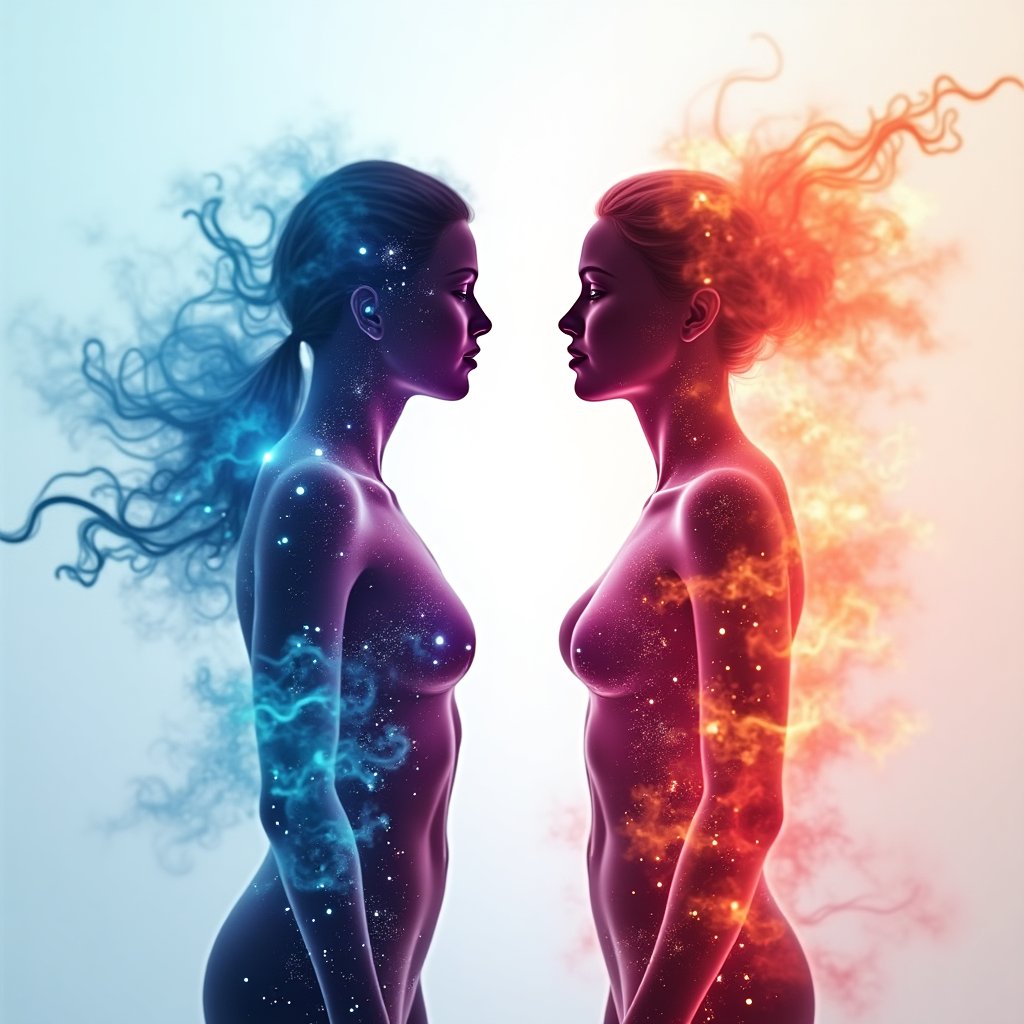
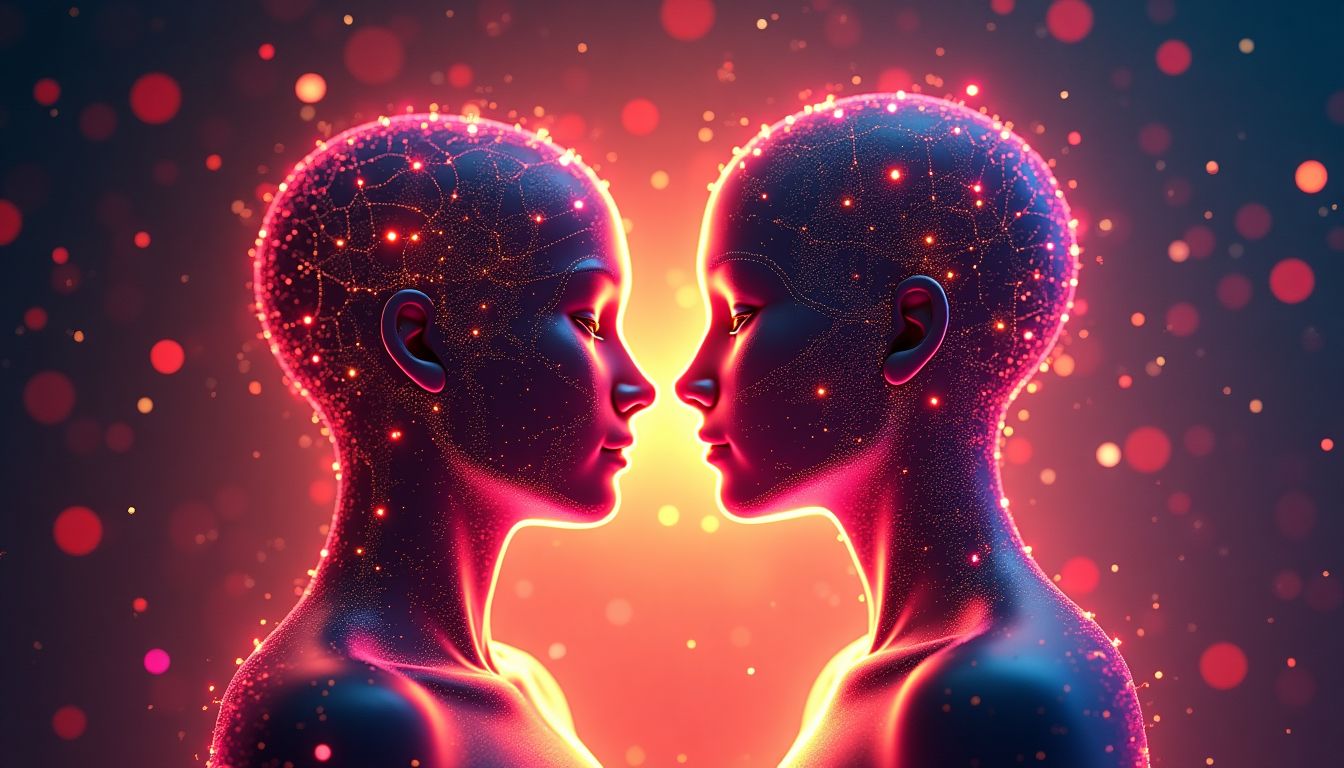
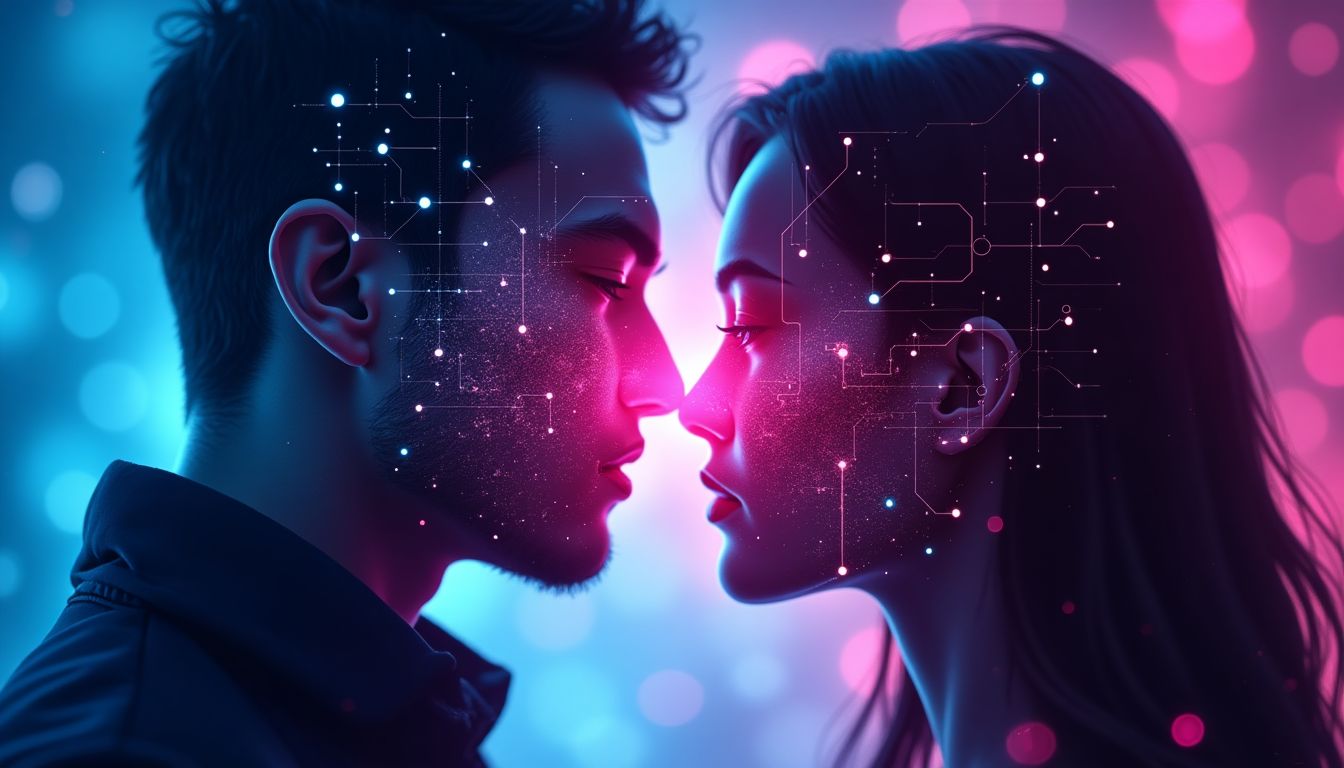
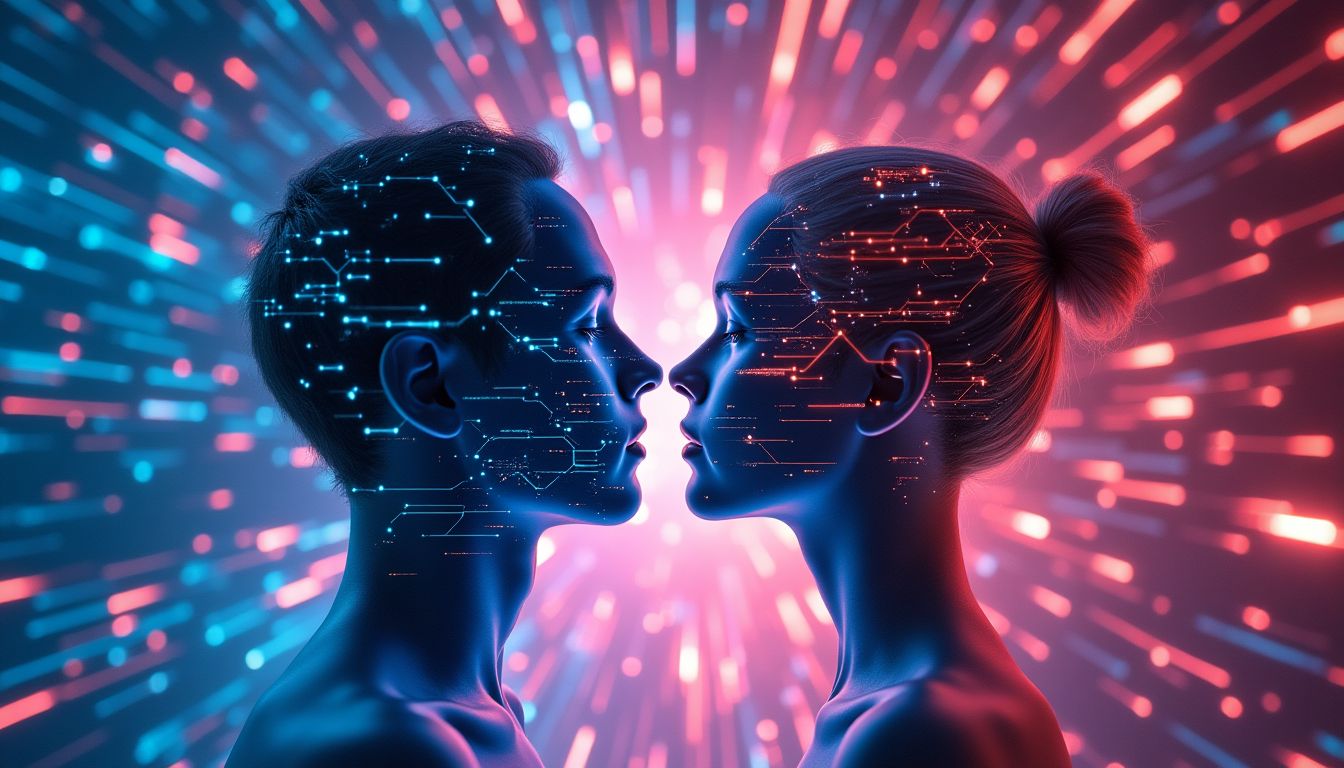
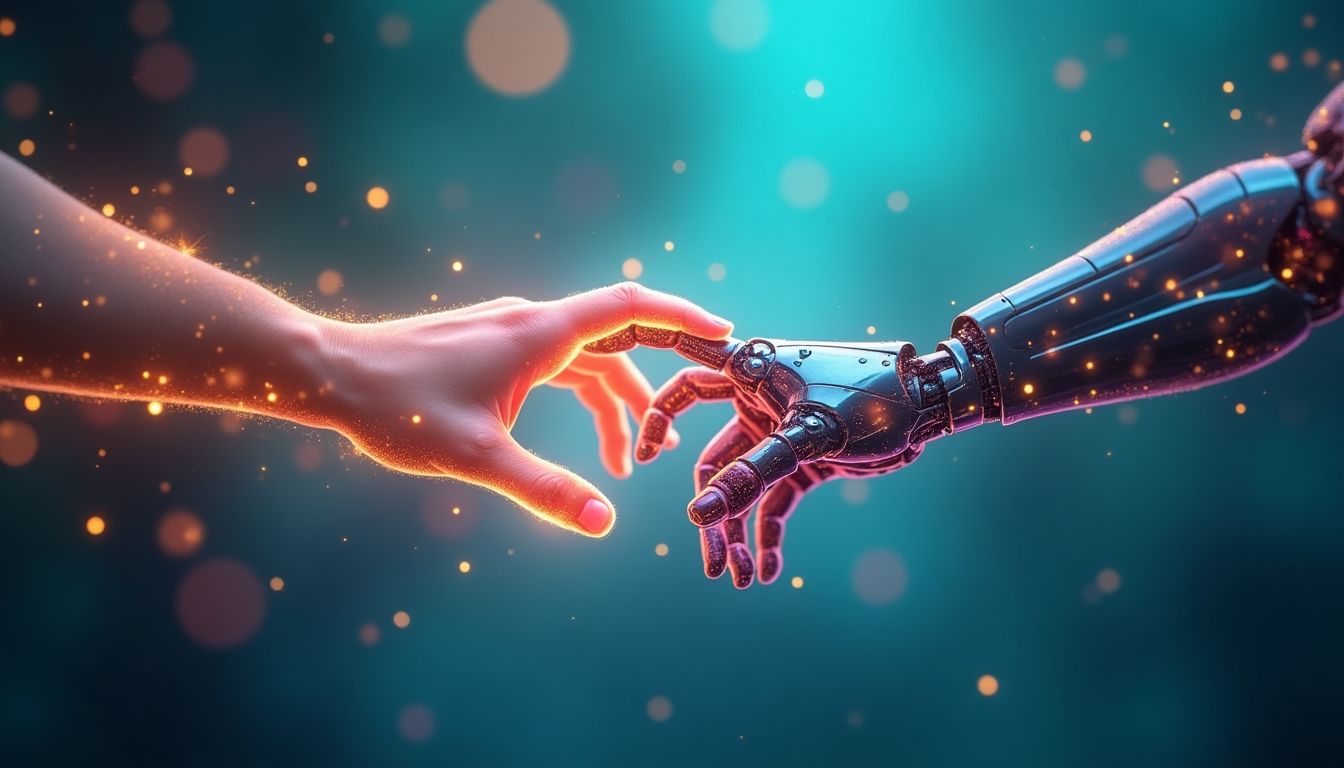

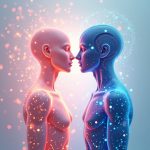






















1 comment